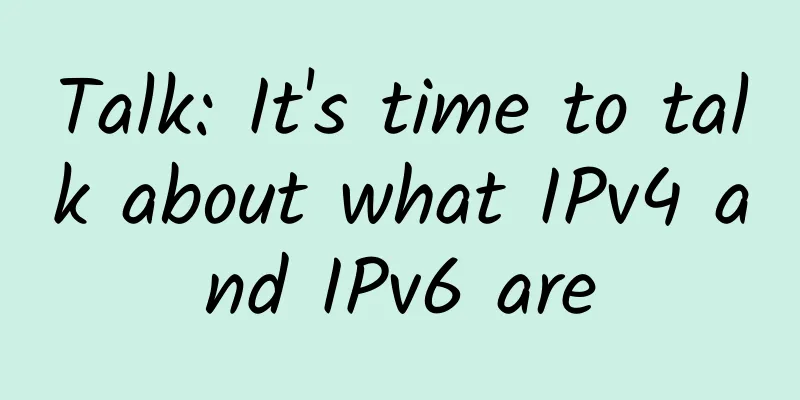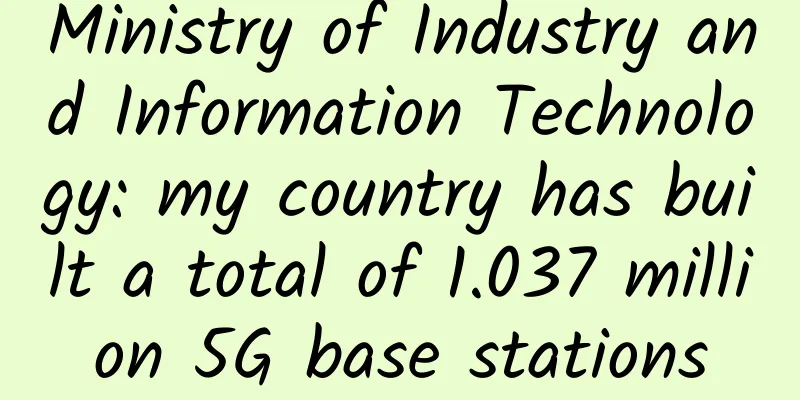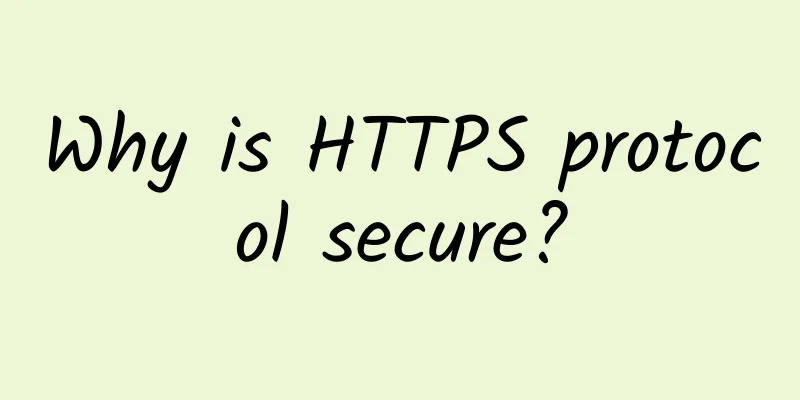Talk: It's time to talk about what IPv4 and IPv6 are

|
On November 25, 2019, the RIPE NCC, which is responsible for the allocation of Internet resources in the UK, Europe, the Middle East and parts of Central Asia, announced that its last IPv4 address space reserve pool was completely exhausted at 15:35 UTC + 1 on November 25, and all 4.3 billion IPv4 addresses have been allocated. In fact, as early as the late 1980s, the world had begun to realize that this problem would occur. The development and deployment of IPv6 is mainly to solve this problem. What is IPv4? IPv4 is the abbreviation of Internet Protocol version 4, which is translated into Chinese as the fourth version of Internet Communication Protocol (TCP/IP Protocol), and is usually referred to as Internet Protocol version 4.
IPv4 uses 32-bit (4-byte) addresses, so there are only 4,294,967,296 (2^32) addresses in the address space. An IPv4 address can be written in any format that represents a 32-bit integer value, but for ease of human reading and analysis, it is usually written in dotted decimal form, that is, the four bytes are written separately in decimal, separated by dots. Therefore, the address format of an IPv4 address is usually nnn.nnn.nnn.nnn, such as:
192.168.1.255 is a 4-byte IP address divided into four segments in dotted decimal notation. Each segment has one byte, and one byte has 8 bits. Therefore, the range of numbers that can be represented by 8 bits is 0 - 255. Therefore, the format of an IPv4 address is nnn.nnn.nnn.nnn, where 0<=nnn<=255 and each n is a decimal number. Leading zeros can be omitted. IPv4 message format We know that in the TCP/IP five-layer protocol model, a network request must go through the application layer -> transport layer -> network layer -> data link layer -> physical layer. During the request process, a request data will also be packaged layer by layer from the application layer to the physical layer. Each layer will package the data message of the previous layer, add a layer of header information, and then pass it to the next layer. Therefore, as a network layer protocol, IPv4 also includes the IP header and data part in its message structure. Among them, the IPv4 header length is variable, ranging from 20 to 60 bytes. First The IPv4 message header contains 14 fields, 13 of which are required and 1 is optional. The above picture is the header format of an IPv4 message. You can see that the IPv4 header contains a lot of content, such as version number, header length, identifier, fragment offset, survival time, protocol, etc. Since this part is not the focus of this article, the message header will not be introduced in detail here. Readers can refer to the above picture to learn on their own. data In the message, in addition to the header, there is another most important part, which is the data part. The data field is not part of the header, so it is not included in the header checksum. As mentioned earlier, the network layer will encapsulate the message from the transport layer into data, add a header, and then pass it to the link layer. Therefore, the data part of the IPv4 message is the protocol message content of the transport layer, such as TCP, UDP, etc. Why is IPv4 exhausted? The global management body for IP addresses is the Internet Assigned Numbers Authority (IANA), which has five local Internet Registries (RIRs) under it. Theoretically, IPv4 can provide up to 2^32 (about 4.29 billion) IP addresses. However, some addresses are reserved for special purposes, such as about 18 million private networks and about 270 million multicast addresses, which also reduces the number of addresses that can be routed on the Internet. As addresses continue to be allocated to end users, the problem of IPv4 address exhaustion also arises. China is the country with the largest number of Internet users in the world, but there are only 0.45 IPv4 addresses per capita. In the IPv4 environment, the Internet addresses of Chinese users need to be dynamically allocated, there is no fixed correspondence between people and addresses, and it is difficult to trace users, which brings potential risks to Internet security and supervision. So, to solve this problem, IPv6 was born. What is IPv6? IPv6 is the abbreviation of Internet Protocol version 6, which is translated into Chinese as Internet Communication Protocol (TCP/IP Protocol) Version 6, usually referred to as Internet Protocol Version 6. IPv6 has a much larger encoding address space than IPv4. It is used to replace IPv4 mainly to solve the problem of IPv4 address exhaustion. At the same time, it also has many improvements on IPv4 in other aspects. IPv6 has a much larger coded address space than IPv4. This is because IPv6 uses 128-bit addresses, while IPv4 uses 32-bit addresses. Therefore, the newly added address space supports 2^128 addresses, which is 340,282,366,920,938,463,463,374,607,431,768,211,456 (I wonder if anyone can read this number?) Some people say that the number of IPv6 addresses may be more than the grains of sand in the world, which is enough to solve the current problem of insufficient IPv4 addresses. IPv6 binary system is 128 bits long, with 16 bits as a group, each group is separated by a colon ":", and can be divided into 8 groups The IPv6 text format is xxxx:xxxx:xxxx:xxxx:xxxx:xxxx:xxxx:xxxx:xxxx, where each x is a hexadecimal number representing 4 bits. For example: 2001:0db8:86a3:08d3:1319:8a2e:0370:7344IPv6 message format Like IPv4, IPv6 messages also contain a header and data part. Unlike IPv4, the header of an IPv6 message is a fixed length of 40 bytes. The figure below shows the structure of the IPv6 message header. IPv6 defines a new packet format to minimize the message headers processed by routers. As can be seen from the figure, compared with IPv4, the IPv6 header content is much less. As network layer protocols, IPv6, like IPv4, encapsulates the message content of the transport layer as its own data. There is no difference in this point, so we can say that the main difference between IPv6 and IPv4 in terms of messages is the difference in the message header. IPv4 VS IPv6 After introducing IPv4 and IPv6, let's take a look at the differences between these two protocols as a whole. 1. Address (1) IPv4 length is 32 bits (4 bytes) The text format of an IPv4 address is nnn.nnn.nnn.nnn, where 0<=nnn<=255 and each n is a decimal number. Leading zeros can be omitted. The maximum number of printable characters is 15, excluding the mask; (2) IPv6 length is 128 bits (16 bytes) The text format of an IPv6 address is xxxx:xxxx:xxxx:xxxx:xxxx:xxxx:xxxx:xxxx:xxxx, where each x is a hexadecimal digit representing 4 bits. Leading zeros can be omitted. Double colons (::) can be used once in the text format of an address to specify any number of zero bits. For example, ::ffff:10.120.78.40 represents an IPv4-mapped IPv6 address. 2. Address Resolution Protocol
3. IP header
4. Security
5. Address Type
6. Private and public addresses
7. Compared with IPv4, IPv6 has the following advantages:
Someone made a vivid summary, which is "fast, good and cheap" Transition from IPv4 to IPv6 On the one hand, due to the exhaustion of IPv4, and on the other hand, due to the "more, faster, better, and cheaper" features of IPv6, more and more companies are beginning to choose to use IPv6. So, what do you need to do if you want to convert an IPv4 network to an IPv6 network? First of all, it is clear that IPv6 is not an upgrade of the IPv4 protocol, but a brand new protocol. The two are not compatible with each other. In order to ensure the smooth evolution from IPv4 to IPv6, the Internet Engineering Task Force (IETF) established a special working group to conduct research and formed three types of technical solutions: dual stack technology, tunnel technology, and protocol conversion technology (NAT-PT). 1. Dual stack technology IPv4 and IPv6 have network layer protocols with similar functions. They are based on the same hardware platform. The same host runs both IPv4 and IPv6 protocol stacks. Nodes with IPv4/IPv6 dual protocol stacks are called dual stack nodes. These nodes can send and receive both IPv4 and IPv6 packets. They can use IPv4 to communicate with IPv4 nodes, or directly use IPv6 to communicate with IPv6 nodes. Dual stack nodes contain both IPv4 and IPv6 network layers, but the use of transport layer protocols (such as TCP and UDP) is still single. Advantages of dual stack technology:
Disadvantages of dual stack technology:
2. Tunnel technology Tunneling technology refers to encapsulating the header of another protocol data packet directly in front of the header of the original data packet, so that it can be directly transmitted on networks with different protocols. This mechanism is used to connect IPv6 sites on the IPv4 network. The site can be a host or multiple hosts. Tunneling technology encapsulates IPv6 packets into IPv4 packets, or encapsulates IPv4 packets into IPv6 packets. The encapsulated IPv4 packets will be transmitted through the IPv4 routing system or IPv6 packets. Advantages of tunnel technology:
Disadvantages of tunneling technology:
3. Protocol conversion technology NAT-PT is a network address translator with a protocol converter. It is a way for pure IPv6 nodes and IPv4 nodes to communicate with each other. All conversion work including addresses and protocols is completed by network devices. NAT-PT includes static and dynamic NAT-PT. Both provide one-to-one mapping of IPv6 addresses and IPv4 addresses. However, dynamic NAT-PT requires an IPv4 address pool for dynamic address conversion. Advantages of NAT-PT technology:
Disadvantages of NAT-PT technology:
Dual stack technology, tunnel technology, and protocol conversion technology cooperate and work together during the transition from IPv4 to IPv6, solving the coexistence and interoperability problems of IPv4 and IPv6 during the transition period and ensuring the smooth evolution from IPv4 to IPv6. With the above switching methods, switching principles and technical guarantees, and in line with the development trend of the Internet, the country is actively promoting the deployment of IPv6. The 44th "Statistical Report on the Development of China's Internet" of the China Internet Network Information Center (CNNIC) pointed out that as of June 2019, the number of IPv6 addresses in our country was 50,286 blocks/32, ranking first in the world; the number of active IPv6 users reached 130 million, accounting for approximately 15% of my country's Internet users. The impact of IPv6 on China China connected to the Internet 20 years later than developed countries and is a latecomer in the Internet industry. Although we are a major country in Internet products and applications, our operating system is still foreign and we still have gaps in core technologies. If China wants to carry out technological innovation in the IPv4 environment, it has almost no chance. But when it comes to IPv6, we are at a similar starting point to developed countries, so we do have a chance. In the IPv4 era, China did not have root servers, and adding new ones was almost impossible. However, the "Snowman Project" initiated by the China Next Generation Internet National Engineering Center has completed the installation of 25 IPv6 root servers around the world, of which 4 are deployed in China, breaking the dilemma of China not having root servers in the past. In addition, the international Internet has more than 8,000 standards. In the IPv4 era, China only proposed the Chinese encoding standard. But now China has proposed more than 100 standards for IPv6. It can be said that IPv6 has opened up a new innovation space for the development of China's Internet. Therefore, with the exhaustion of IPv4 and the massive use of IPv6, China's position in the international Internet will become more and more important! |
<<: Want to handle tens of millions of traffic? You should do this!
Recommend
The Ministry of Industry and Information Technology reminds you to set the SIM card password in time. Doing these four things after losing your phone is more important than calling the police.
[[347353]] If you lose your phone, do you know wh...
Trip.com QUIC high availability and performance improvements
First, the QUIC multi-process deployment architec...
Discussion on the Application of SDN in Wide Area Network
Internet industry application trends and problems...
What IoT strategies do global operators have?
After several years of preparation and developmen...
5 wireless IoT communication trends to watch in 2020
Everything is going wireless. According to a new ...
Xentain: $1.25/month-1GB/15GB SSD/1Gbps unlimited traffic/Fremont data center
New merchant, mainly with the discount code, the ...
How to collect intranet information
The essence of penetration testing is information...
HostYun launches new Hong Kong U.2 SSD series VPS, 200Mbps bandwidth VPS monthly payment starts from 18 yuan
In addition to the new computer room, HostYun als...
Enterprises struggle to keep up with security and compliance when it comes to collaboration tools
Theta Lake, an AI solutions provider, surveyed 10...
How edge computing and fog computing change the way IoT is used
It’s hard to keep up with the latest trends and e...
With spending of the three major operators declining, has China's 5G construction slowed down?
In 2020, China's 5G network construction deve...
Alibaba established the first ecological IoT alliance to open up technical standards
At the IoT Partner Program Conference 2017 (ICA) ...
LOCVPS: 30% off on CN2 line KVM in the Netherlands, 2G package renewal in Tai Po, Hong Kong, starting from 44 yuan per month
LOCVPS (Global Cloud) is an early established Chi...
LMT to build 5G air-ground hybrid network with Omnispace
According to foreign media reports, Lockheed Mart...
When will 5G become mainstream, or is it already mainstream?
Is 5G still waiting for a "killer app"?...








![[11.11] HostingViet: Vietnam VPS annual payment 40% off, 2GB/20G SSD/unlimited traffic/annual payment starting from 193 yuan](/upload/images/67cabd1cac212.webp)
